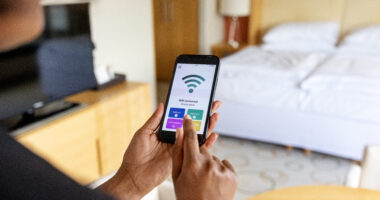.jpg)

Singh says a smart thermometer reading is particularly useful for people who have only mild symptoms and can be spared a visit to the doctor, as well as those who can’t access or afford medical care. That means the thermometers can catch people that health departments miss, and provide a more accurate picture of how a flu wave is building.
University researchers collaborating with Kinsa employees have compared the company’s data with that of health departments to see how well they match, and to determine to what extent users’ temperature readings and symptom reports can help model and predict outbreaks. On the national and state levels, researchers found that the Kinsa data correlated closely with official surveillance measures but detected flu-like cases up to three weeks before they were reported by health officials—likely because of the lag between someone’s fever starting and their illness being officially reported.
Of course, smart thermometers aren’t the only form of digital surveillance. Analyzing Google search data can also provide a head start on predicting an outbreak—people often google their symptoms before going to the doctor. But their searches are usually based only on perceived symptoms, which can be subjective. “The advantage of Kinsa is that it relies on objective temperature readings, as opposed to solely self-reported symptoms,” says Sarah Ackley, a postdoctoral fellow in epidemiology and biostatistics at the University of California, San Francisco, who has examined the accuracy of Kinsa’s regional predictions.
Kinsa thermometers are sold at major pharmacies, and the company also distributes them for free to families and staff at US public schools that apply for them. So far, the New York City Department of Health and Mental Hygiene is the only government agency that has partnered with the company on a citywide basis, distributing more than 100,000 thermometers free of charge to 500 public schools since September 2021.
New York City is reporting very high levels of flu-like illnesses at the moment. In the week ending December 3, 13 percent of patient visits to health care facilities were due to respiratory illness involving a fever combined with cough or sore throat. This is above the national baseline of 2.5 percent for this winter season. According to Kinsa’s forecast, the current wave of cases will peak slightly later in New York City than nationally—meaning the risk of infection is predicted to remain high into the new year. “We believe it’s going to be the most severe season, and we’ve been projecting that for a while,” says Singh.
However, the extent to which New York City’s health department is using Kinsa’s real-time data this flu season is unclear: “The work with Kinsa is a pilot, and we’re still exploring how best to use the data,” a department spokesperson wrote to WIRED by email.
Health agencies tend to be relatively conservative when it comes to new data systems, says Jay Varma, a professor of population health sciences at Cornell University who was involved in the New York pilot project. “When new systems arise, it can take time to understand how best to use them for decision-making,” he says. Moreover, new systems require additional staff and resources, he says, and there is always the question of how to maintain those resources in the future.









